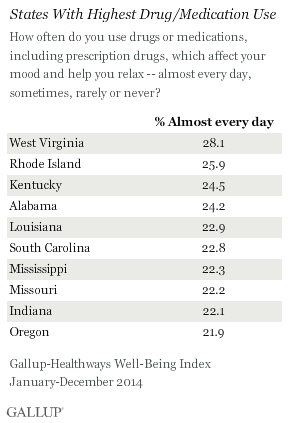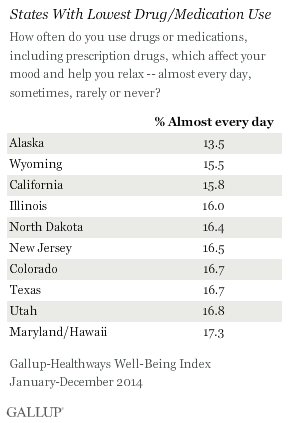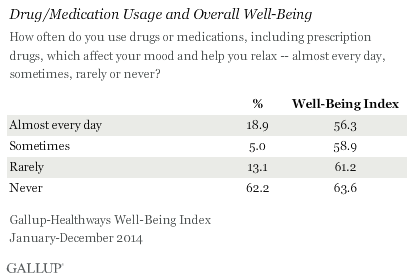Mood-Altering Drug Use Highest in West Virginia, Lowest in Alaska
Reposted with permission from Gallup

These data are based on interviews with at least 450 residents of each state from January to December 2014, as part of the Gallup-Sharecare Well-Being Index. While the question specifically refers to drugs that “affect your mood or help you relax,” the interpretation of that description is left up to respondents and could include prescription drugs, recreational drugs, alcohol or nicotine.
More than one in five residents of Kentucky, Alabama, Louisiana, South Carolina, Mississippi and Missouri report using a drug or medicated substance to alter their mood or relax on a near-daily basis. Indiana and Oregon round out the top 10.
An analysis by the Centers for Disease Control and Prevention found that Southern states are among those with the highest rates for prescribing narcotic painkillers. Southern states also house the most frequent cigarette smokers, according to prior Gallup-Sharecare research.
Lower rates of drug and medication use were in a regionally diverse group of states. After the three states that have the lowest drug use rates (Alaska, Wyoming and California), about one in six residents in Illinois, North Dakota, New Jersey, Colorado, Texas and Utah say they use such drugs almost every day.
Americans Who Frequently Use Drugs to Relax Have Lower Well-Being
Nationally, 18.9% of Americans report using a mood-altering substance nearly every day, while the majority, 62.2% say they never use such drugs. About two in 10 Americans report using drugs or medication rarely or sometimes.
Those who use drugs that affect their mood almost every day have a slightly lower average Well-Being Index score (56.3) than those who use such drugs sometimes (58.9), and a significantly lower score than those who take drugs or medication to relax rarely (61.2) or never (63.6).
Bottom Line
Americans take drugs and medication, both legal and illegal, for a variety of reasons. Some adults may be taking prescribed medication as a result of an illness, such as depression or anxiety. Meanwhile, others could be using an illegal substance for recreational purposes on a near-daily basis.
While using drugs to relax almost every day is clearly linked to lower well-being, the direction of the relationship is unclear. One possibility is that taking mood-altering drugs or medication nearly every day contributes to lower well-being. But a more probable explanation is that Americans who already have lower well-being are more likely to use drugs or medication to relax or alter their mood, possibly to help cope with challenges related to their low purpose, social, financial, physical or community well-being.
Though the question wording leaves this open to interpretation by the individual respondent, on the whole, those who are the most frequent users of mood-altering drugs have the lowest well-being. States with high percentages of residents who take drugs or medication to relax may be able to reduce these rates by addressing the underlying well-being issues that may compel residents to rely on mood-altering substances.
Read the complete State of American Well-Being report.
Survey Methods
Results are based on telephone interviews conducted Jan. 2-Dec. 30, 2014, as part of the Gallup-Sharecare Well-Being Index, with a random sample of 176,702 adults in 2014, aged 18 and older, living in all 50 U.S. states and the District of Columbia. The margin of sampling error is ±1 to ±2 percentage points for most states, but is close to ±4 percentage points for states with small populations, such as North Dakota, Wyoming, Vermont and Alaska. All reported margins of sampling error include computed design effects for weighting.
Each sample of national adults includes a minimum quota of 50% cellphone respondents and 50% landline respondents, with additional minimum quotas by time zone within region. Landline and cellular telephone numbers are selected using random-digit-dial methods.
Learn more about how the Gallup-Sharecare Well-Being Index works.


